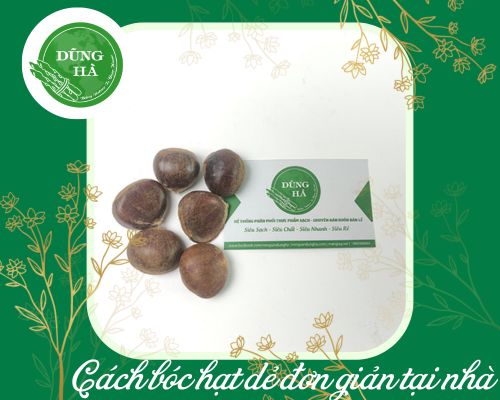Tin tức
[Tips] How to peel chestnuts quickly, even children can do it
Chestnuts are entering the early part of the season and you can buy chestnuts easily anywhere. You bought raw chestnuts from the market but don’t know how to peel off the outer shell in the most convenient and easiest way? Chestnuts are delicious, fatty and have a lot of healthy nutritional values. However, it is delicious, but many people are afraid of peeling chestnuts. If you do not know how to peel, the chestnut kernel inside will be broken and lose its taste and aesthetics. Don’t worry too much. The following article shared by Dung Ha Dry Agricultural Products will answer in the most detail to you how to peel chestnuts quickly and simply, even children can do it.
1. What are chestnuts? Chestnut origin?
Before we learn together about the fastest and most convenient ways to peel chestnuts, let’s find out what chestnuts are!
1.1 What are chestnuts?
Chestnuts are also known by another name, Son Hac Dao, English name is Chestnut. This is a kind of nut with a light sweet taste, with a nutty filling, when eaten, it has a characteristic fatty taste.
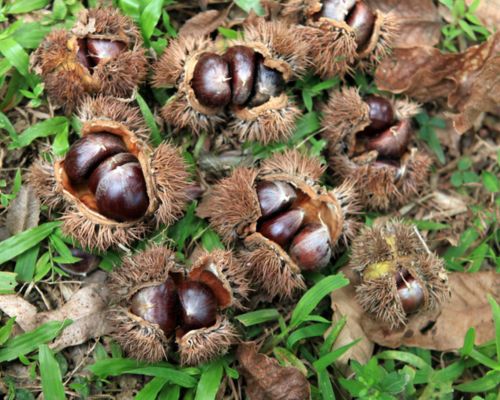
==> See more cheap American chestnuts products
1.2 Chestnut origin?
Chestnut is the seed of the chestnut tree, which is a woody, perennial plant. The tree occurs a lot in Europe and the Asian peninsula, the most common is in Türkiye.
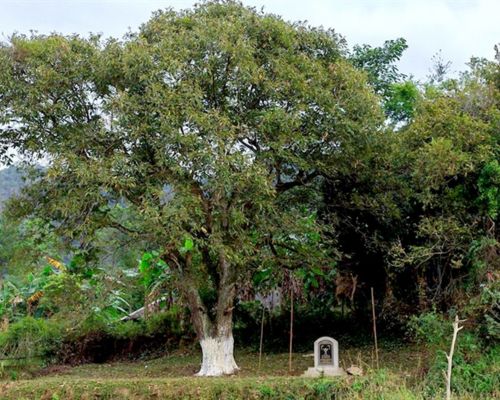
In Vietnam, the favorable climate is also a favorable condition for people to cultivate chestnut trees. Chestnut tree is a cold-loving tree, they can live in the temperature from 4 degrees C to 38 degrees C. However, the most suitable temperature to grow is from 20 – 21 degrees C. Some locations Famous names for growing chestnuts include Lang Son, Lao Cai, Cao Bang. Of these three places, Trung Khanh District (Cao Bang Province) is considered the “capital” of growing the largest and most famous chestnuts in the country.
See more: Where to sell delicious American pistachios at Dry Food
So do you know how to peel chestnuts properly, so that they don’t break? Let’s continue to find out together.
2. How to peel chestnuts quickly at home, children can do it too?
2.1 Cook chestnuts
- Step 1: Using a knife, cut a small hole in the middle of the chestnut
- Step 2: Put a teaspoon of fine salt in the pot with 500ml of purified water. Stir until the salt dissolves
- Step 3: Put the pot of pure salted water on the stove and bring to a boil
- Step 4: Boil the salt water, put the chestnuts in and boil them for 7-10 minutes
- Step 5: Remove the chestnuts from the convex, let the chestnuts cool and drain
- Step 6: Peel off the chestnut shell, take the chestnut kernel inside and enjoy
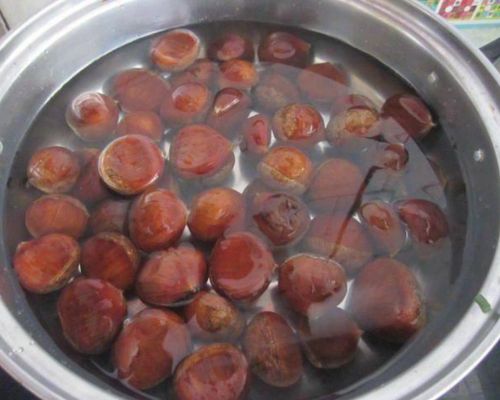
Thus, with only 6 simple steps, you have peeled the hard shell of discarded chestnuts. The chestnut filling inside was not broken at all.
2.2 Soak chestnuts in warm water
- Step 1: You peel chestnuts from the outer coat and then wash chestnuts under running water
- Step 2: Using scissors, cut the top of the chestnut into a cross shape
- Step 3: Put 1 teaspoon of fine salt in a bowl of boiling water. Stir until the salt dissolves
- Step 4: Put the chestnuts in a bowl of boiling water. Close the lid, and soak (incubate) the chestnuts for 10 minutes
- Step 5: Remove the chestnuts from the bowl of boiling water
- Step 6: Using your hands, skillfully peel off the soft chestnut shell from the chestnut kernel
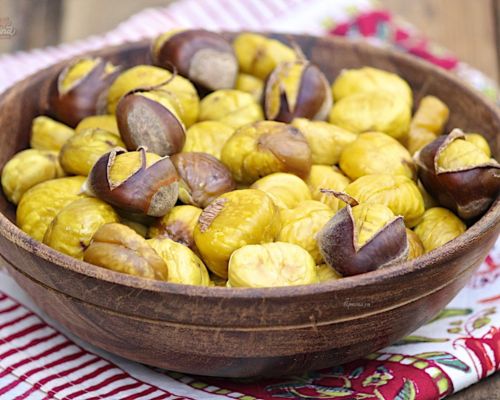
2.3 Use a rice cooker
- Step 1: You peel chestnuts from the outer coat and then wash chestnuts under running water
- Step 2: Using scissors, cut a horizontal line across the chestnut body
- Step 3: Put 500ml of pure water + chestnuts into the rice cooker
- Step 4: Plug in the power and press the “Warm” button
- Step 5: After 15 minutes, the rice cooker will jump to the reheat button and you can unplug and remove the chestnuts from the pot
- Step 6: Incubate chestnuts for about 5 minutes in a clean bucket towel
- Step 7: Gently peel off the chestnut shell with your hands
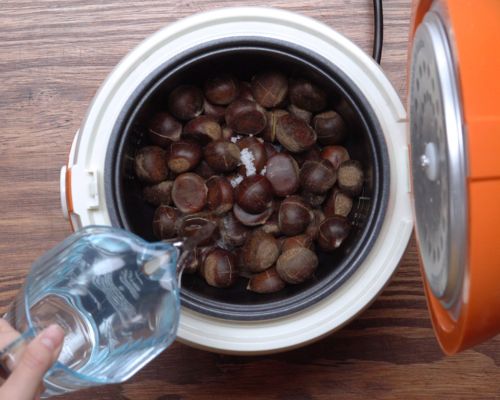
This is a great method, you can absolutely apply it.
2.4 Use the microwave
- Step 1: Wash chestnuts 2-3 times under clean running water. Let the chestnuts dry, drain
- Step 2: Using scissors, cut a line across the chestnut body
- Step 3: Preheat the microwave to 170 degrees Celsius for 10 minutes
- Step 4: Neatly put chestnuts in the microwave
- Step 5: Proceed to turn ripe chestnuts at a temperature of 150 degrees C within 7 minutes
- Step 6: Remove the chestnuts from the microwave, let the chestnuts cool and slowly peel off the chestnut skin

2.5 Sun drying chestnuts
- Step 1: Wash chestnuts 2-3 times under clean running water
- Step 2: Using scissors, cut the top of the chestnut into a cross shape
- Step 3: Dry chestnuts in direct sunlight for 2-3 days, the shells dry and crack
- Step 4: Use your hands skillfully to peel off the chestnut shell
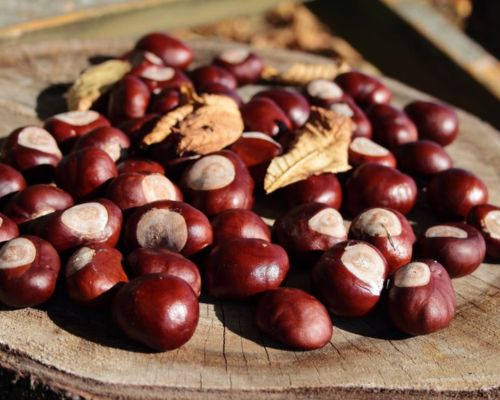
Note: This method of drying chestnuts needs to be dried in a cool, dry, clean place. Avoid drying in polluted places, toxic garbage.
3. How to preserve chestnuts in full flavor for a long time without spoiling?
3.1 With raw chestnuts
- Store in the refrigerator: Raw chestnuts should be stored in the refrigerator. Put the chestnuts in a ziplock bag or food container and put them neatly in the fridge
- Sealed packing: After buying chestnuts, you pack them tightly to prevent air and moisture from entering
- Avoid direct sunlight: Chestnuts should be stored in a cool place and out of direct sunlight. Sunlight can dehydrate chestnuts and cause them to spoil quickly
- Avoid high temperatures: Chestnuts should be stored at a cool temperature. Keep away from high temperature sources
- Freezing (Optional): If you want to preserve them longer, you can freeze the chestnuts. Frozen chestnuts can keep their freshness longer
See more: [Pocket] How to preserve summer food for a long time without spoiling?
3.2 With ripe chestnuts
- Chestnut color: Choose chestnuts with a hard, even brown skin. Do not choose seeds with signs of mold or damage
- Store at the right temperature: Ripe chestnuts should be stored at a cool temperature. Average temperature 15 – 20 degrees Celsius. Do not expose chestnuts to moisture
- Store in glass jars: To keep chestnuts from moisture, mold,… Ban or store ripe chestnuts in a glass jar with a tight-fitting lid.
- Check chestnuts regularly: Check ripe chestnuts regularly for any damaged, rotten nuts. Immediately remove damaged, moldy seeds


 Tiếng Việt
Tiếng Việt